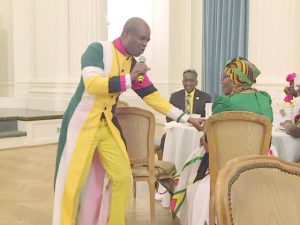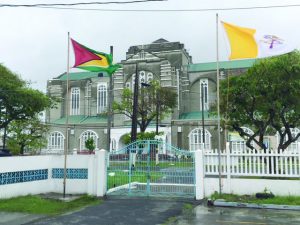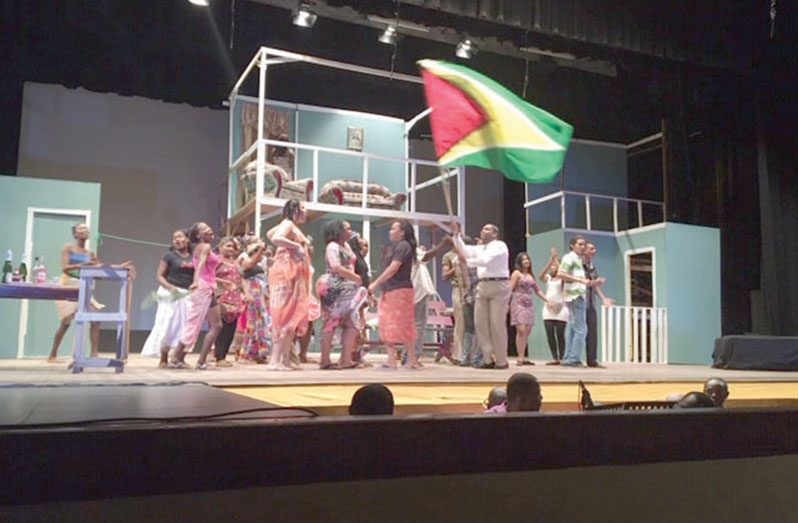By Francis Quamina Farrier
HOW time flies! So too, The Golden Arrowhead, all over the Land of Many Waters. For elderly Guyanese, they realise that they are special. They lived under the “Union Jack” in the past, and now under “The Golden Arrowhead”. They are now elderly and have vivid memories of colonial British Guiana when, among other things, as students, they sang “patriotic” songs such as “Rule Britannia, Britannia rule the waves, Britons never, never shall be slaves.” Now, imagine the ridiculousness of young Africans and Indians in British Guiana, the majority of whom were descendants of enslaved Africans and indentured Indians, singing with gusto such “patriotic” songs! That was the era of what is referred to as “Massa Day.” That was the era when overseers on sugar plantations, as Dr. Cheddi Jagan used to say, “Hardly knew the difference between tall grass and young sugarcane.” They were usually young English, Scottish, Welsh or Irish who were recruited by the giant sugar production companies Bookers and Sandbach Parker. It was the era when Sugar was King; when those young white men came — and many with an attitude of superiority — and were greeted as “Massa” or “Sahib” by the locals.

But those days are now long gone. Our ancestors knew and kept their places in the colonial society for the better part. However, some were planning and executed the inevitable change. By dint of hard work for a better way of life, the people’s representatives in British Guiana were successful in their fight to gain political independence for their country. Colonial British Guiana was elevated to independent Guyana on May 26, 1966. Forbes Burnham and Cheddi Jagan were heralded as the principal national leaders. The story of how they hugged each other at the National Park just after Col. Desmond Roberts had hoisted the Golden Arrowhead for the first time, has been told many times. Businessman Peter D’Aguiar who was of Portuguese heritage, headed the conservative political party, The United Force (UF). Stephen Campbell emerged as the Leader of the Indigenous Guyanese. Sadly, he died just two weeks before independence in May 1966. Guyanese were now going to rule themselves. No more “Rule Britannia.” The first relatively simple thing which had to be done was a new name for the country. There were quite a series of extremely humorous debates as regards the change of spelling from Guiana to Guyana. Four years later, on February 23, 1970, the country was further elevated to the status of a Cooperative Republic. The cooperative movement was identified to be the principal means of economic development.
As a playwright, I wrote a play that foreshadowed that future of our country. It was for the National Independence Playwrighting Competition. The plot of “TIMBERLINE’ is as follows: the workers on a timber concession are at odds about their future when the white colonists had decided to close down the concession and return to England. “What are we to do?” the workers worried. That was until they decided to pool their individual meagre financial resources and establish a cooperative society to run the timber concession. I entered that play of mine, “TIMBERLINE” in the National Independence Playwriting Competition. It won the “Best Play” First Prize. What needs to be emphasized, is that the theme and plot of that play were about the cooperative movement. Guyana was elevated to a Cooperative Republic some four years later. Another play of mine with a national theme, was “Journey to Freedom” in which the action commences on the evening of May 25, 1966, as residents of a community complex are preparing to head down to the National Park in Georgetown for the Independence Celebration.
Back in the colonial days, there was apartheid practised right here in British Guiana. Not only on the Sugar Belt but also in the Bauxite Industry and others such as the timber industry. Most folks in speedboats going by Stampa Island in the Essequibo River, located about 10 miles north of Bartica, are unaware that the now uninhabited island was once active with a large sawmill and other buildings. There were also scores of workers including managerial personnel of Englishmen living and working on Stampa island. The timber was supplied from Manaka, a timber concession owned by the CDC, a British Company. Manaka is located on the west bank of the Essequibo River, directly west of Fort Island. One of the plays which I have written is entitled “MANAKA” and is about life in that timber community.

Growing up on the eastern extremes of McDoom village, facing the sugar cane fields, I saw for myself the way the young whites from Britain operated. They riding on their mules while a “Mule Boy” – usually of Indian heritage – trotted behind carrying such things as cloak and umbrella for the white overseer. The estate roads were usually extremely muddy during the rainy season, and hard and dusty during the sunny dry season. The Mule Boy was always bare-footed. By the time he reached manhood, his toes were all clearly and permanently separated due to the mud squeezing between them during their growing-up years.
During the 15-year period in which I interviewed elders for my Radio Programme Series, “The Eighty Plus Club” I had quite several former sugar workers as guests. They spoke of the pleasant inter-action between African and Indian sugar workers. There was centenarian, Gajadar, an East Indian Immigrant who lived at Anna Regina, and who I had interviewed for my Eighty Plus Club. He spoke in detail of his work as a weeder in the sugar cane fields at Anna Regina on the Essequibo Coast. He also related the inter-action of Barbadians of African Heritage and how they got along well with the Guianese of African Heritage as well as those of Indian Heritage. Gajadar, small of stature, spoke with a deep Indian Guyanese accent, tinted with a bit of a stutter. I thoroughly enjoyed interviewing him and he remains the favourite of all the East Indian Immigrants who I have had the opportunity to interview for my “Eighty Plus Club” Radio Programme Series.
At this time – February 2021 – there are no more East Indian Immigrants here in Guyana. That Immigration programme ended in 1917. I feel privileged that I was someone who got the opportunity to interview some of them while they were still with us, and were pleased to share their knowledge and experiences. There was a particular Immigrant who told me of being brought to British Guiana by his father. Working their five-year contract and opting to return to India. To his father’s dismay, they were not welcomed back by the villagers in India. As such, they returned to British Guiana. There are so many stories that I garnered from those elders who shared their life stories with me when I interviewed them for my Eighty Plus Club. Their stories are a part of the story of Guyana – the history of Guyana. Having interviewed Elder Guyanese from all the ten Regions of the country over a fifteen year period, one gets a good idea of where our Elders desired the country to go in the future along Highway Unity, travelling happily under the freedom of the GOLDEN ARROWHEAD.



.jpg)








